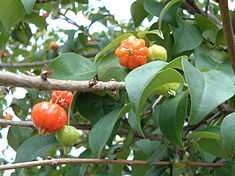Eugenia uniflora
| ||||||||||||||||||||||||||||||||||||||||||||||||||||||||||||||||
The Pitanga, Surinam Cherry, Brazilian Cherry, or Cayenne Cherry (Eugenia uniflora) is a plant in the family Myrtaceae, native to tropical South America's east coast ranging from Suriname to southern Brazil, as well as parts of Paraguay and Uruguay.[1][2] Known as Pitanga throughout Brazil or Ñangapirí in surrounding countries, The plant is relatively pest resistant, easy to grow and high in antioxidants.[3] The Surinam Cherry is often used in gardens as a hedge or screen. The tree was introduced to Bermuda for ornamental purposes but is now out of control and listed as an invasive species.[4]
Description

Eugenia uniflora is a large shrub or small tree with a conical form, growing slowly to 8 meters in height. When bruised, crushed or cut, the leaves and branches have a spicy resinous fragrance, which can cause respiratory discomfort in susceptible individuals. New leaves are bronze, copper or coppery-pinkish in color, maturing to a deep glossy green, up to 4 cm long. During winter the leaves turn red.
Flowers have 4 white petals and are borne on slender long stalks, with a conspicuous central cluster of white stamens ending in yellow anthers. Flowers develop into ribbed fruits 2 to 4 cm in diameter, starting out as green, then ranging through orange, scarlet and maroon as they ripen.
Etymology
The word "Pitanga" originates from the Tupi word pi'tãg, which means "red", a reference to the fruit's color.[5]
Uses
Fruit
The taste ranges from sweet to sour, depending on the cultivar and level of ripeness (the darker red to black range is quite sweet, while the green to orange range is strikingly tart). Its predominant food use is as a flavoring and base for jams and jellies. The fruit is high in Vitamin C and a source of Vitamin A.
Leaves
The leaves are spread on house floors in Brazil, so that when crushed underfoot they exude a smell which repels flies.
Medical studies
Eugenia uniflora has several significant pharmacological properties. Its essential oil is antihypertensive,[6] antidiabetic,[7] antitumor[8] and analgesic,[9] and it has shown antiviral and antifungal activity.[10] It has performed against microorganisms such as Trichomonas gallinae (in vitro),[11] Trypanosoma cruzi[12] and Leishmania amazonensis.[13]
It also shows significant anti-inflammatory properties,[14] and is used extensively as a folk remedy in South America against stomach diseases.[15]
See also
- Jatobá, a fruit also known as Brazilian cherry
Gallery
-

Eugenia uniflora fruits
-

Eugenia uniflora
-
Eugenia uniflora
-
Eugenia uniflora
-

Eugenia uniflora -young leaves
References
- ↑ Berry Helped to Put Reality Show Chef on Top - New York Times
- ↑ Morton, Julia (1987). "Surinam cherry". Fruits of warm climates. Miami, FL. pp. 386–388.
- ↑ A curious crop | The Honolulu Advertiser
- ↑ Bermuda Conservation - Surinam Cherry
- ↑ FERREIRA, A. B. H. Novo Dicionário da Língua Portuguesa. Segunda edição. Rio de Janeiro: Nova Fronteira, 1986. p.1 341
- ↑ Consolini AE, Baldini OA, Amat AG (1999). "Pharmacological basis for the empirical use of Eugenia uniflora L. (Myrtaceae) as antihypertensive.". J Ethnopharmacol. 66 (1): 33–9. PMID 10432205.
- ↑ Matsumura, T; Kasai, M; Hayashi, T; Arisawa, M; Momose, Y; Arai, I; Amagaya, S; Komatsu, Y (2000). "a-glucosidase Inhibitors From Paraguayan Natural Medicine, Nangapiry, The Leaves Of Eugenia Uniflora". Pharm Biol 38 (4): 302–7. doi:10.1076/1388-0209(200009)3841-AFT302. PMID 21214481.
- ↑ Ogunwande IA, Olawore NO, Ekundayo O, Walker TM, Schmidt JM, Setzer WN (2005). "Studies on the essential oils composition, antibacterial and cytotoxicity of Eugenia uniflora L.". International Journal of Aromatherapy. 15 (3): 147–152.
- ↑ Amorim ACL, Lima CKF, Hovell AMC, Miranda ALP, Rezende CM (2009). "Antinociceptive and hypothermic evaluation of the leaf essential oil and isolated terpenoids from Eugenia uniflora L. (Brazilian Pitanga).". Phytomedicine. 16 (10): 923–8. doi:10.1016/j.phymed.2009.03.009. PMID 19423309.
- ↑ Costa DP, Filho EGA, Silva LMA, et al (2010). "Influence of fruit biotypes on the chemical composition and antifungal activity of the essential oils of Eugenia uniflora leaves.". Journal of the Brazilian Chemical Society 21 (5): 851–8.
- ↑ Ibikunle GF, Adebajo AC, Famuyiwa FG, Aladesanmi AJ, Adewunmi CO (2011). "In-vitro evaluation of anti-trichomonal activities of Eugenia uniflora leaf.". Afr J Tradit Complement Altern Med. 8 (2): 170–6. PMID 22238499.
- ↑ Santos KK, Matias EF, Tintino SR, Souza CE, Braga MF, Guedes GM, Rolón M, Vega C, de Arias AR, Costa JG, Menezes IR, Coutinho HD (2012). "Anti-Trypanosoma cruzi and cytotoxic activities of Eugenia uniflora L.". Exp Parasitol. 131 (1): 130–2. doi:10.1016/j.exppara.2012.02.019. PMID 22426246.
- ↑ Rodrigues KA, Amorim LV, de Oliveira JM, Dias CN, Moraes DF, Andrade EH, Maia JG, Carneiro SM, Carvalho FA (2013). "Eugenia uniflora L. Essential Oil as a Potential Anti-Leishmania Agent: Effects on Leishmania amazonensis and Possible Mechanisms of Action.". Evid Based Complement Alternat Med. 2013: 279726. doi:10.1155/2013/279726. PMC 3590759. PMID 23533469.
- ↑ Schapoval, E E; Silveira, S M; Miranda, M L; Alice, C B; Henriques, A T (Dec 1994). "Evaluation of some pharmacological activities of Eugenia uniflora L". J Ethnopharmacol 44 (3): 137–42. PMID 7898120.
- ↑ Tábata. T. Garmus, L.C. Paviani, F. A. Cabral (2013). "Extracts From Pitanga Leaves (Eugenia Uniflora L.) With Sequential Extraction In Fixed Bed Using Supercritical Co2, Ethanol And Water As Solvents" (PDF). Department of Food Engineering, University of Campinas. Retrieved 2013-05-10.
External links
| Wikimedia Commons has media related to Eugenia_uniflora. |
| Wikispecies has information related to: Eugenia_uniflora |
- Purdue University New Crop Resource Online Program
- Eugenia uniflora in the Global Invasive Species Database
- Eugenia uniflora information from the Pacific Island Ecosystems at Risk project (PIER)
- Weed risk assessment for Eugenia uniflora for Hawaii/Pacific Retrieved 2010-06-20.
- Bermuda Department of Conservation Services, Invasive Species Page for Suriname Cherry.


